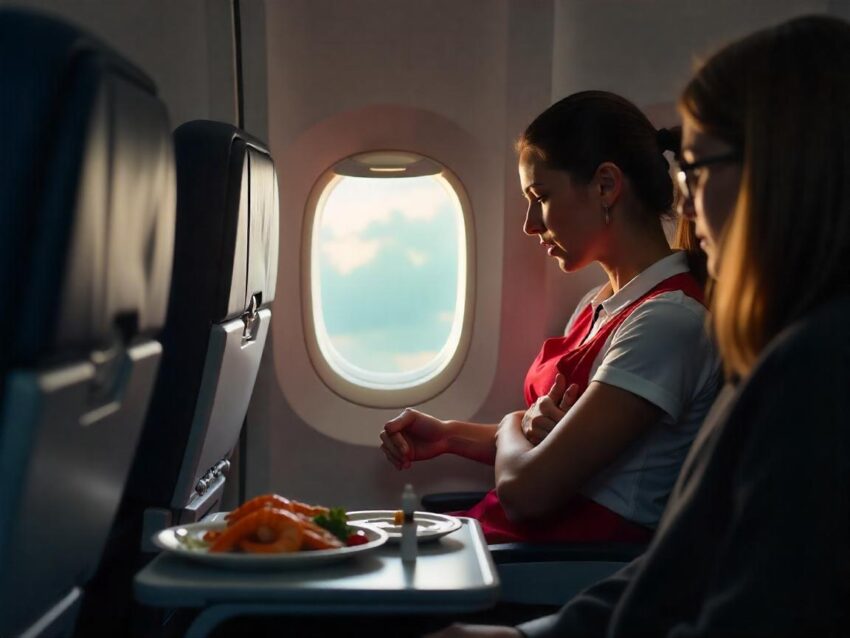
Singapore Airlines is being sued after a passenger suffered a severe allergic reaction mid-flight, leading to a dramatic emergency landing. Now, the case is raising global concerns over in-flight food safety—and the stakes couldn’t be higher. What started as a calm journey on board Singapore Airlines quickly turned into a terrifying medical crisis. The passenger’s reaction mid-flight was so severe, the airline had no choice but to make an emergency landing. But that’s just the beginning.
This isn’t just another lawsuit—it’s a story of trust broken at 30,000 feet. And now, as Singapore Airlines faces scrutiny, questions swirl about the real state of food safety aboard global carriers. Why did the allergic reaction happen? How did the meal slip through? Who’s responsible—and what happens next? The lawsuit has ignited a wave of fear, outrage, and debate. The full truth is unfolding now—and the implications could change how airlines handle allergies forever.
A Flight Gone Wrong: Allergic Reaction at 30,000 Feet Leads to Legal Turbulence for Singapore Airlines
What was supposed to be a routine Business Class flight from Germany to New York quickly turned into a medical emergency that forced an unplanned landing in France. Now, Singapore Airlines faces a lawsuit from a U.S. passenger whose in-flight meal reportedly triggered a severe and life-threatening allergic reaction.
Dr. Doreen Benary, a pediatric emergency physician based in New York, is at the center of this growing legal and public safety storm. After allegedly informing the cabin crew of her shellfish allergy, she claims she was still served a meal containing shrimp. Within moments of consumption, her symptoms escalated rapidly, forcing the aircraft to divert and land for urgent medical intervention.
The incident has reignited a vital question in aviation safety: are airlines truly prepared to manage severe allergies in the skies?
What Went Wrong: The Shrimp Allergy That Grounded a Flight
Onboard the Singapore Airlines flight, Dr. Benary was reportedly served a Business Class meal that contained shrimp. She had already disclosed her shellfish allergy to the crew. Despite this, she claims she unknowingly consumed a portion of the dish before realizing the presence of the allergen.
Soon after, her condition deteriorated quickly. Symptoms intensified mid-flight, prompting immediate concern among passengers and crew. The crew made the urgent decision to divert the aircraft for an emergency landing in France, where Dr. Benary received treatment at two separate medical facilities.
Emergency landings are not taken lightly. They disrupt schedules, incur massive operational costs, and most critically, signal a serious health threat. This case shows how even one oversight in food handling can jeopardize lives and lead to widespread operational fallout.
The Lawsuit: What Dr. Benary Is Demanding
Following the incident, Dr. Benary filed a legal complaint against Singapore Airlines. In the document, she asserts that the airline failed to meet its duty of care, especially after being directly informed of her medical condition.
She claims the incident caused her extreme physical suffering, long-lasting mental distress, and permanent disruption to her quality of life. She’s now seeking full and fair compensation—an amount to be determined in court.
At the heart of the lawsuit is a key allegation: that the cabin crew did not appropriately record or act on critical medical information. This, she argues, led to avoidable injury and trauma.
Airline Responsibility: Where the Industry Stands Now
Airlines are obligated to respond to passenger health disclosures seriously. Many have systems in place to mark allergies in seat assignments and meal requests. However, this incident raises alarms about how consistently those systems are applied—and how well crew members are trained to follow them.
In-flight meals are often prepared in advance and stored in bulk. One wrong label, miscommunication, or lack of verification can turn a standard service into a critical emergency.
This is not an isolated concern. Allergy-related incidents on aircraft have been rising, as more passengers disclose sensitivities to common allergens like nuts, dairy, gluten, and shellfish. However, protocols still vary widely between carriers.
Growing Global Pressure on Airline Food Safety
This high-profile case is part of a wider conversation. Travelers across the world are demanding more transparency and consistency when it comes to food safety on board.
Major airlines like American, Delta, and British Airways have faced public scrutiny for unclear allergen labeling and lack of in-flight medical readiness. Meanwhile, some regional carriers have already begun banning high-risk ingredients on certain routes.
However, there’s still no international standard mandating how allergies are handled mid-air. That lack of uniformity continues to put vulnerable passengers at risk.
Dr. Benary’s lawsuit could become a legal turning point. If she wins, it may set a precedent that forces airlines to overhaul allergen protocols—possibly leading to global policy changes.
Travel Health in Focus: What Passengers Can Do Now
This case is a wake-up call—not just for airlines, but for passengers too.
Here’s what every traveler with allergies should do before flying:
- Inform the airline multiple times, including when booking, during check-in, and directly to the cabin crew.
- Bring medical documentation, including allergist notes and emergency treatment instructions.
- Carry prescribed medications, such as epinephrine auto-injectors, in easily accessible places.
- Avoid high-risk in-flight meals, and consider bringing approved, sealed snacks or meals from home.
- Stay vigilant during meal service, and ask specific questions before eating.
These steps can’t guarantee complete protection, but they can dramatically reduce risk and ensure faster responses if something goes wrong.
What’s Next for Singapore Airlines?
Singapore Airlines has not publicly disclosed its internal response to the incident, but the stakes are high. Beyond potential financial damages, the brand risks reputational harm if passengers perceive a lapse in safety.
With a strong track record and a reputation for luxury, SIA must now show how it will rebuild trust. Industry watchers expect the airline to review its allergy-handling policies and enhance crew training protocols in the wake of this lawsuit.
Other carriers will be watching closely. A shift in Singapore Airlines’ internal processes may ripple through the industry, especially among airlines aiming to stay competitive in the premium travel segment.
Final Boarding Call: Why This Case Matters
Dr. Benary’s lawsuit is more than a courtroom drama. It’s a global reckoning with how airlines handle medical safety. As food allergies become more common and severe, carriers can no longer afford to treat them as secondary concerns.
Every meal served at 30,000 feet needs to meet the same care and precision passengers expect on the ground—because in the air, there’s no margin for error.
The skies may be friendly, but for those with allergies, they must also be safe.
The post Singapore Airlines Sued After Passenger Suffers Severe Allergic Reaction Mid-Flight, Prompting Emergency Landing and Raising Global Concerns Over In-Flight Food Safety appeared first on Travel And Tour World.from Travel And Tour World https://ift.tt/5wI7kSx
via >EPR


